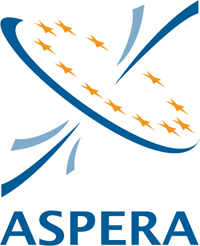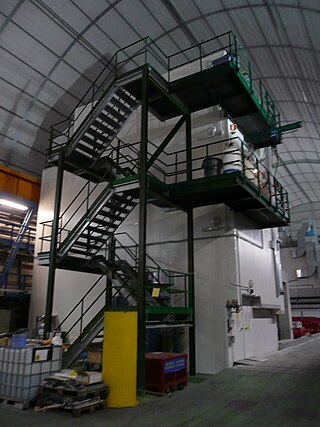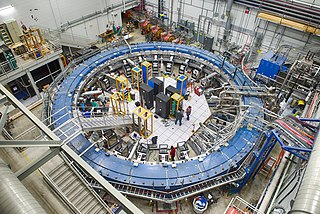
ATLAS is the largest general-purpose particle detector experiment at the Large Hadron Collider (LHC), a particle accelerator at CERN in Switzerland. The experiment is designed to take advantage of the unprecedented energy available at the LHC and observe phenomena that involve highly massive particles which were not observable using earlier lower-energy accelerators. ATLAS was one of the two LHC experiments involved in the discovery of the Higgs boson in July 2012. It was also designed to search for evidence of theories of particle physics beyond the Standard Model.
A wire chamber or multi-wire proportional chamber is a type of proportional counter that detects charged particles and photons and can give positional information on their trajectory, by tracking the trails of gaseous ionization.

The Joint Institute for Nuclear Research, in Dubna, Moscow Oblast, Russia, is an international research center for nuclear sciences, with 5500 staff members including 1200 researchers holding over 1000 Ph.Ds from eighteen countries. Most scientists, however, are eminent Russian scientists.

ALICE is one of eight detector experiments at the Large Hadron Collider at CERN. The other seven are: ATLAS, CMS, TOTEM, LHCb, LHCf, MoEDAL and FASER.
The Large Volume Detector (LVD) is a particle physics experiment situated in the Gran Sasso laboratory in Italy and is operated by the Italian Institute of Nuclear Physics (INFN). It has been in operation since June 1992, and is a member of the Supernova Early Warning System. Among other work, the detector should be able to detect neutrinos from our galaxy and possibly nearby galaxies. The LVD uses 840 scintillator counters around a large tank of hydrocarbons. The detector can detect both charged current and neutral current interactions.

Laboratori Nazionali del Gran Sasso (LNGS) is the largest underground research center in the world. Situated below Gran Sasso mountain in Italy, it is well known for particle physics research by the INFN. In addition to a surface portion of the laboratory, there are extensive underground facilities beneath the mountain. The nearest towns are L'Aquila and Teramo. The facility is located about 120 km from Rome.

The Istituto Nazionale di Fisica Nucleare is the coordinating institution for nuclear, particle, theoretical and astroparticle physics in Italy.
Astroparticle physics, also called particle astrophysics, is a branch of particle physics that studies elementary particles of astronomical origin and their relation to astrophysics and cosmology. It is a relatively new field of research emerging at the intersection of particle physics, astronomy, astrophysics, detector physics, relativity, solid state physics, and cosmology. Partly motivated by the discovery of neutrino oscillation, the field has undergone rapid development, both theoretically and experimentally, since the early 2000s.
PVLAS aims to carry out a test of quantum electrodynamics and possibly detect dark matter at the Department of Physics and National Institute of Nuclear Physics in Ferrara, Italy. It searches for vacuum polarization causing nonlinear optical behavior in magnetic fields. Experiments began in 2001 at the INFN Laboratory in Legnaro and continue today with new equipment.

ASPERA is a network of national government agencies responsible for coordinating and funding national research efforts in astroparticle physics.

The Cryogenic Rare Event Search with Superconducting Thermometers (CRESST) is a collaboration of European experimental particle physics groups involved in the construction of cryogenic detectors for direct dark matter searches. The participating institutes are the Max Planck Institute for Physics (Munich), Technical University of Munich, University of Tübingen (Germany), University of Oxford and the Istituto Nazionale di Fisica Nucleare.

Borexino is a particle physics experiment to study low energy (sub-MeV) solar neutrinos. The detector is the world's most radio-pure liquid scintillator calorimeter. It is placed within a stainless steel sphere which holds the photomultiplier tubes (PMTs) used as signal detectors and is shielded by a water tank to protect it against external radiation and tag incoming cosmic muons that manage to penetrate the overburden of the mountain above.

The NA49 experiment was a particle physics experiment that investigated the properties of quark–gluon plasma. It took place in the North Area of the Super Proton Synchrotron at CERN from 1991-2002. It used a large-acceptance hadron detector to investigate reactions induced by the collision of various heavy ions on targets made of a variety of elements.
The DarkSide collaboration is an international affiliation of universities and labs seeking to directly detect dark matter in the form of weakly interacting massive particles (WIMPs). The collaboration is planning, building and operating a series of liquid argon time projection chambers (TPCs) that are employed at the Gran Sasso National Laboratory in Assergi, Italy. The detectors are filled with liquid argon from underground sources in order to exclude the radioactive isotope 39
Ar, which makes up one in every 1015 (quadrillion) atoms in atmospheric argon. The Darkside-10 (DS-10) prototype was tested in 2012, and the Darkside-50 (DS-50) experiment has been operating since 2013. Darkside-20k (DS-20k) with 20 tonnes of liquid argon is being planned as of 2019.

Antonio Ereditato is an Italian physicist, currently associate researcher at Fermilab, Batavia, USA, and Emeritus professor at the University of Bern, Switzerland, where he has been Director of the Laboratory for High Energy Physics from 2006 to 2020. From 2021 to 2022 he has been Visiting Professor at the Yale University, USA. He carried out research activities in the field of experimental neutrino physics, of weak interactions and strong interactions with experiments conducted at CERN, in Japan, at Fermilab in United States and at the LNGS in Italy. Ereditato has accomplished several R&D studies on particle detectors: wire chambers, calorimeters, time projection chambers, nuclear emulsions, detectors for medical applications.

Paolo Giubellino is an experimental particle physicist working on High-Energy Nuclear Collisions. Currently he is the joint Scientific Managing Director of the Facility for Antiproton and Ion Research (FAIR) and the GSI Helmholtz Centre for Heavy Ion Research (GSI) and Professor at the Institute of Nuclear Physics of the Technische Universität Darmstadt.

Muon g − 2 is a particle physics experiment at Fermilab to measure the anomalous magnetic dipole moment of a muon to a precision of 0.14 ppm, which will be a sensitive test of the Standard Model. It might also provide evidence of the existence of entirely new particles.
CSES , or Zhangheng, is a Chinese–Italian space mission dedicated to monitoring electromagnetic field and waves, plasma parameters and particle fluxes induced by natural sources and artificial emitters in the near-Earth space. Austria contributes to one of the magnetometers.
The Laboratori Nazionali di Legnaro is one of the four major research centers of the Italian National Institute for Nuclear Physics (INFN). The primary focus of research at this laboratory is in the fields of nuclear physics and nuclear astrophysics, where five accelerators are currently used. It is one of the most important facilities in Italy for research in these fields. The main future project of the laboratory is the Selective Production of Exotic Species (SPES), in which various radionuclides will be produced for research and medicinal purposes.
Hybrid pixel detectors are a type of ionizing radiation detector consisting of an array of diodes based on semiconductor technology and their associated electronics. The term “hybrid” stems from the fact that the two main elements from which these devices are built, the semiconductor sensor and the readout chip, are manufactured independently and later electrically coupled by means of a bump-bonding process. Ionizing particles are detected as they produce electron-hole pairs through their interaction with the sensor element, usually made of doped silicon or cadmium telluride. The readout ASIC is segmented into pixels containing the necessary electronics to amplify and measure the electrical signals induced by the incoming particles in the sensor layer.












